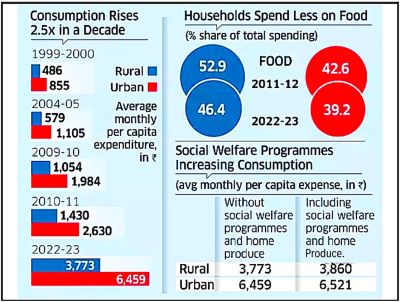Context-
The National Sample Survey Office (NSSO) recently released a detailed report based on the Household Consumption Expenditure Survey (HCES) for 2022-23. Along with the report, unit-level data on household consumption expenditure (HCE) has been made available to the public.
Approach of Measurement
Defining the ‘Poor’
In the Indian context, various committees constituted by the government, including the Lakdawala, Tendulkar, and Rangarajan Committees, have defined the poor as those below the ‘poverty line’ (PL). The PL is a monetary equivalence based on household monthly per capita consumer expenditure (MPCE) that should be sufficient for the household to purchase the food and non-food items included in the poverty line basket (PLB).
1. Lakdawala Committee: Anchored the PL and PLB, which included food and non-food items, to calorie norms of 2,400 kcal per capita per day for rural areas and 2,100 kcal per capita per day for urban areas.
2. Tendulkar Committee: Did not anchor the PL to a calorie norm.
3. Rangarajan Committee: Based the PL on ‘certain normative levels of adequate nourishment, clothing, house rent, conveyance, education, and a behaviorally determined level of other non-food expenses’.
Measuring Nutritional Levels
The methodology of this analysis involves several steps:
1. Determining Average Daily Per Capita Calorie Requirement (PCCR): The PCCR for a healthy life is based on the recommended energy requirements for Indians of different age-sex-activity categories as per the latest (2020) report of ICMR-National Institute of Nutrition. The PCCR is a weighted average of the calorie requirements of persons in different age-sex-activity categories, with corresponding weights based on the estimated proportions of these categories as per the Periodic Labour Force Survey, 2022-23.
2. Classifying Expenditure Classes: Estimated persons are arranged into 20 fractile classes of MPCE (poorest to richest), each comprising five percent of the population. The average per capita per day calorie intake (PCCI) and average MPCE (food and non-food) are derived for each class based on the data of HCES 2022-23.
3. Deriving Average MPCE on Food: From this all-India distribution, the average MPCE on food linked to the normative level of the PCCR is derived. This average per capita expenditure on food is considered the minimum amount a household must spend on food items for its members to maintain a healthy life.
4. Calculating Total MPCE Threshold: The average per capita expenditure on food is combined with the average MPCE on non-food items for the poorest five percent to derive the total MPCE threshold necessary for spending on food items (ensuring adequate nourishment) and on non-food items with a bare minimum expenditure on the latter. This all-India total MPCE threshold is adjusted for price differentials across States/UTs using general Consumer Price Index numbers to derive the corresponding State/UT-specific total MPCE thresholds.
5. Determining Proportion of ‘Poor’: State/UT-wise proportion of ‘poor’/deprived is derived as the proportion of persons below such total MPCE thresholds. The proportion of ‘poor’/deprived for the country is derived as the weighted average of the State/UT-wise proportions of deprived persons, with respective weights as the projected populations of the States/UTs as of March 1, 2023, based on the July 2020 report of the National Commission on Population. The analysis involves certain approximations in deriving the calorie intake figures at the household level, especially where the HCES data reports aggregate quantity figures for certain grouped items.
Results

Calorie Requirement and Expenditure Thresholds
● PCCR: Estimated to be 2,172 kcal for rural India and 2,135 kcal for urban India.
● All-India Threshold Total MPCE (at 2022-23 prices):
○ Rural India: ₹2,197 (food: ₹1,569 and non-food: ₹628)
○ Urban India: ₹3,077 (food: ₹2,098 and non-food: ₹979)
Proportion of ‘Poor’
● Rural Areas: 17.1%
● Urban Areas: 14%
● If considering the non-food expenditure of the poorest 10% instead of the poorest 5%, the threshold total MPCE increases to:
○ Rural Areas: ₹2,395
○ Urban Areas: ₹3,416
● The corresponding increase in the proportion of deprived:
○ Rural India: 23.2%
○ Urban India: 19.4%
Nutritional Deficiency
● Average PCCI of the Poorest:
○ Poorest 5% in Rural India: 1,564 kcal
○ Next 5% in Rural India: 1,764 kcal
○ Poorest 5% in Urban India: 1,607 kcal
○ Next 5% in Urban India: 1,773 kcal
These figures fall significantly short of the PCCR.
Implications and Recommendations
Government Welfare Programs:
The Indian government has implemented various welfare programs aimed at improving the living standards and health conditions of the poor. However, the findings of this analysis underscore the need for more targeted nutritional schemes, specifically designed to address the dietary deficiencies of the poorest of the poor.
Targeted Nutritional Schemes:
To effectively combat nutritional deficiency, the following strategies are recommended:
1. Enhanced Food Subsidy Programs: Increase the scope and reach of food subsidy programs to ensure that the poorest households can access sufficient quantities of nutritious food.
2. Nutrition Education: Implement educational campaigns to raise awareness about the importance of balanced diets and optimal nutrition practices.
3. Special Nutritional Supplements: Provide special nutritional supplements to vulnerable groups, including children, pregnant women, and the elderly, to meet their specific dietary needs.
4. Regular Monitoring: Establish a robust system for regular monitoring and evaluation of nutritional intake among the poorest segments, allowing for timely interventions and policy adjustments.
Conclusion
Addressing nutritional deficiency among the poor is crucial for ensuring a healthier and more productive population. By implementing targeted nutritional schemes and enhancing existing welfare programs, the government can make significant strides in improving the health and well-being of the most vulnerable segments of society. The insights provided by the HCES 2022-23 data offer a valuable foundation for formulating effective policies and interventions to achieve this goal.
|
Probable Questions for UPSC Mains Exam- 1. How does the Household Consumption Expenditure Survey (HCES) 2022-23 data help in identifying the nutritional deficiencies among the poorest segments of the population in India, and what are the specific calorie intake findings for rural and urban areas? (10 marks, 150 Words) 2. What recommendations are provided to address the nutritional deficiencies among the poorest of the poor in India, and how do these suggestions aim to improve the effectiveness of existing government welfare programs? (15 marks, 250 Words) |
Source- The Hindu







